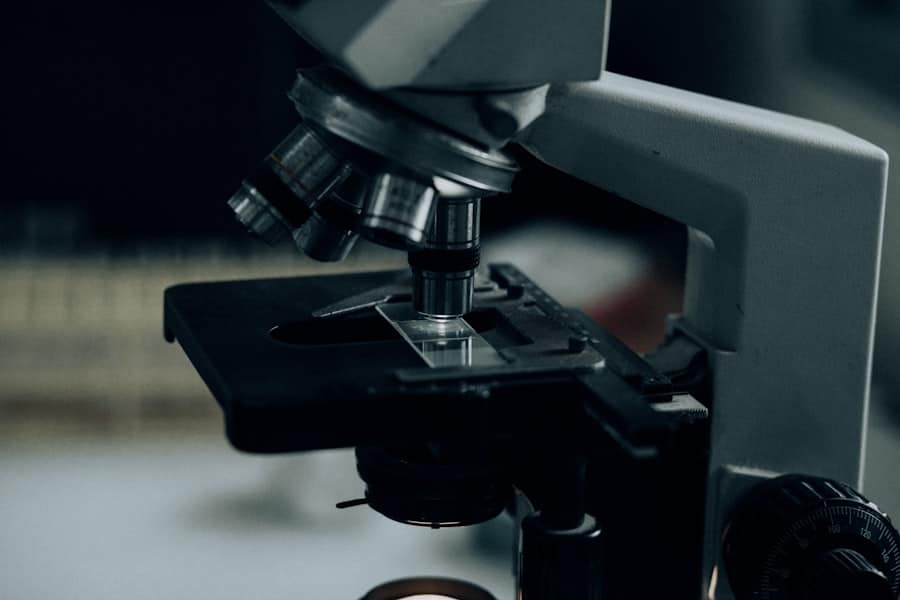The integration of artificial intelligence (AI) into lab diagnostics represents a transformative shift in the healthcare landscape. As the volume of medical data continues to grow exponentially, traditional diagnostic methods often struggle to keep pace with the demand for accuracy and efficiency. AI technologies, particularly machine learning and deep learning algorithms, have emerged as powerful tools capable of analyzing vast datasets, identifying patterns, and making predictions that can enhance diagnostic processes.
This evolution is not merely a technological advancement; it signifies a paradigm shift in how healthcare providers approach patient care, diagnosis, and treatment planning. AI’s role in lab diagnostics encompasses a wide range of applications, from automating routine tasks to providing advanced analytical capabilities that can lead to earlier and more accurate diagnoses. The potential for AI to improve patient outcomes is significant, as it can reduce human error, streamline workflows, and facilitate personalized medicine.
As healthcare systems worldwide grapple with the challenges of rising costs and increasing patient populations, the adoption of AI in lab diagnostics offers a promising avenue for enhancing the quality of care while optimizing resource utilization.
Key Takeaways
- AI in lab diagnostics is revolutionizing the way medical tests are conducted and interpreted, leading to faster and more accurate results.
- Current applications of AI in lab diagnostics include image analysis, predictive analytics, and data interpretation, improving efficiency and accuracy in diagnosis.
- The advantages of AI in lab diagnostics include improved accuracy, faster turnaround times, and the ability to handle large volumes of data.
- Challenges and limitations of AI in lab diagnostics include the need for high-quality data, potential biases in algorithms, and the requirement for continuous validation and monitoring.
- Future developments in AI for lab diagnostics may include the integration of multiple data sources, personalized medicine approaches, and enhanced decision support systems.
Current Applications of AI in Lab Diagnostics
AI is currently being utilized in various facets of lab diagnostics, demonstrating its versatility and effectiveness across multiple domains. One prominent application is in the analysis of medical imaging. Algorithms trained on large datasets of radiological images can assist radiologists in detecting anomalies such as tumors or fractures with remarkable accuracy.
For instance, Google’s DeepMind has developed AI systems that can analyze retinal scans to identify diabetic retinopathy, achieving performance levels comparable to that of expert ophthalmologists. This capability not only expedites the diagnostic process but also enhances the ability to catch conditions at earlier stages when they are more treatable. Another significant application of AI in lab diagnostics is in pathology.
Digital pathology involves the digitization of tissue samples, allowing for the application of AI algorithms to analyze histopathological images. These algorithms can assist pathologists in identifying cancerous cells and grading tumors based on their characteristics. A notable example is PathAI, a company that leverages machine learning to improve the accuracy of cancer diagnoses by providing pathologists with decision support tools that highlight areas of concern within tissue samples.
This integration not only aids in reducing diagnostic errors but also helps pathologists manage their workload more effectively by prioritizing cases that require immediate attention.
Advantages of AI in Lab Diagnostics

The advantages of incorporating AI into lab diagnostics are manifold and extend beyond mere efficiency gains. One of the most significant benefits is the enhancement of diagnostic accuracy. AI algorithms can analyze complex datasets with a level of precision that often surpasses human capabilities.
For example, studies have shown that AI systems can reduce false positives and false negatives in various diagnostic tests, leading to more reliable outcomes for patients. This increased accuracy is particularly crucial in fields such as oncology, where early detection can significantly impact treatment success rates. Moreover, AI can facilitate faster turnaround times for diagnostic results.
Traditional lab processes can be time-consuming, often leading to delays in patient care. By automating routine tasks such as sample analysis and data entry, AI systems can significantly reduce the time required to obtain results. For instance, AI-driven platforms can process blood samples and generate reports within minutes, allowing healthcare providers to make timely decisions regarding patient management.
This rapid response capability is especially vital in emergency situations where every moment counts.
Challenges and Limitations of AI in Lab Diagnostics
Despite its numerous advantages, the implementation of AI in lab diagnostics is not without challenges and limitations. One major concern is the quality and representativeness of the data used to train AI algorithms. If the training datasets are biased or lack diversity, the resulting models may produce skewed results that do not generalize well across different populations.
For example, an AI system trained predominantly on images from one demographic may struggle to accurately diagnose conditions in individuals from other backgrounds, potentially exacerbating health disparities. Additionally, there are significant technical challenges associated with integrating AI into existing lab workflows. Many laboratories rely on legacy systems that may not be compatible with advanced AI technologies.
The process of digitizing records and implementing new software solutions can be resource-intensive and may require substantial investment in infrastructure and training. Furthermore, there is a risk that over-reliance on AI could lead to deskilling among healthcare professionals, as they may become less adept at performing manual analyses or critical thinking when interpreting results.
Future Developments in AI for Lab Diagnostics
Looking ahead, the future of AI in lab diagnostics appears promising, with several key developments on the horizon. One area of focus is the continued improvement of algorithmic sophistication through advancements in deep learning techniques.
For instance, future algorithms may integrate multimodal data sources—combining imaging data with genomic information—to provide comprehensive insights into patient health. Another exciting development is the potential for real-time diagnostics powered by AI. As wearable technology becomes increasingly prevalent, there is an opportunity to leverage continuous health monitoring data to inform diagnostic processes dynamically.
Imagine a scenario where an AI system analyzes data from wearable devices to detect early signs of disease or monitor chronic conditions in real-time, alerting healthcare providers to potential issues before they escalate. This proactive approach could revolutionize patient management and lead to more personalized treatment strategies.
Ethical and Regulatory Considerations for AI in Lab Diagnostics

The integration of AI into lab diagnostics raises important ethical and regulatory considerations that must be addressed to ensure safe and equitable implementation. One primary concern is patient privacy and data security. The use of large datasets for training AI algorithms necessitates stringent measures to protect sensitive health information from unauthorized access or breaches.
Regulatory bodies must establish clear guidelines regarding data handling practices to safeguard patient confidentiality while enabling innovation. Moreover, there is a pressing need for transparency in AI decision-making processes. Healthcare providers and patients alike must understand how AI systems arrive at their conclusions to foster trust in these technologies.
This transparency is particularly crucial when it comes to high-stakes decisions such as cancer diagnoses or treatment recommendations. Regulatory frameworks should mandate that AI systems provide explanations for their outputs, allowing clinicians to interpret results within the context of their clinical expertise.
Impact of AI on Healthcare Professionals in Lab Diagnostics
The advent of AI in lab diagnostics has profound implications for healthcare professionals working within this domain. On one hand, AI serves as a powerful ally that enhances the capabilities of lab technicians and pathologists by providing them with advanced tools for analysis and decision support. By automating routine tasks and offering insights derived from complex data patterns, AI allows professionals to focus on higher-level clinical reasoning and patient interaction rather than being bogged down by repetitive processes.
Conversely, there are concerns about job displacement as automation becomes more prevalent in laboratory settings. While AI may streamline workflows and improve efficiency, it also raises questions about the future roles of healthcare professionals. It is essential for educational institutions and healthcare organizations to adapt training programs that equip professionals with the skills needed to work alongside AI technologies effectively.
Emphasizing interdisciplinary collaboration between human expertise and machine intelligence will be crucial in ensuring that healthcare professionals remain integral to the diagnostic process.
The Potential of AI in Automating Lab Diagnostics
The potential for artificial intelligence to revolutionize lab diagnostics is immense, offering opportunities for enhanced accuracy, efficiency, and personalized patient care. As current applications demonstrate the effectiveness of AI across various domains—from medical imaging to pathology—there is a clear trajectory toward broader adoption within healthcare systems worldwide. However, realizing this potential requires addressing challenges related to data quality, integration into existing workflows, ethical considerations, and workforce implications.
As we move forward into an era where AI becomes increasingly embedded within lab diagnostics, it is imperative that stakeholders—including healthcare providers, technologists, regulators, and patients—collaborate to navigate these complexities responsibly. By fostering an environment that prioritizes innovation while safeguarding ethical standards and professional integrity, we can harness the full power of AI to transform lab diagnostics into a more accurate, efficient, and equitable component of modern healthcare.
In a related article discussing the best software for user experience (UX) design, it is evident that technology is rapidly advancing in various fields, including healthcare. As seen in “The Future of AI in Automating Lab Diagnostics,” the integration of artificial intelligence in laboratory diagnostics is revolutionizing the way medical tests are conducted and analyzed. This article highlights the importance of user-friendly software in enhancing the overall experience for both healthcare professionals and patients.

